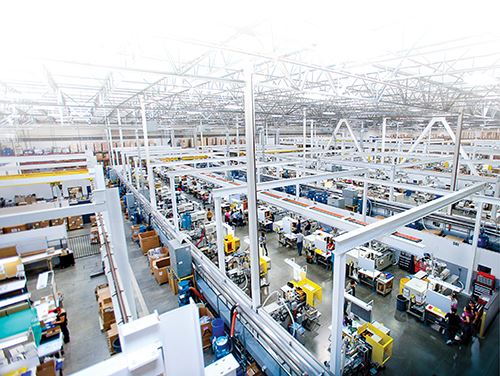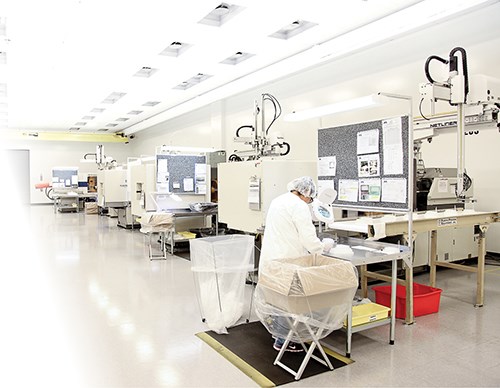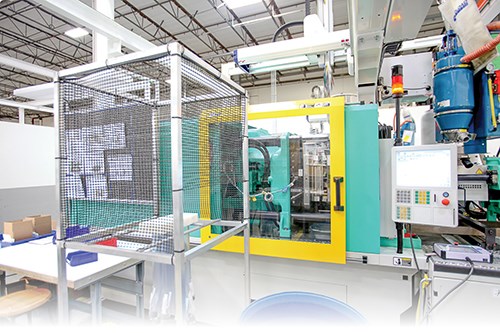Injection Molding, California Style
There are particular challenges associated with plastics processing in the Golden State. But opportunities beckon for those who can overcome them. That’s the story of AMA Plastics.
Seismic-rating of tool racks, two increases in the minimum wage in 18 months, some of the highest utility rates in the nation—California poses unique challenges to the plastics processors that operate there, but the Golden State also promises opportunity to companies that can adapt.
Since 1971, custom injection molder AMA Plastics has adapted, survived and thrived as a California plastics processor, growing from a small family-owned business in Anaheim, with six machines and 15 employees, to one of the largest custom shops west of the Mississippi, running a 165,000-ft2 facility in Riverside housing 93 presses, with the 94th—a two-shot Arburg Allrounder—on order. Employee count is now upwards of 500.
“California’s probably not the state you’d start out to put your operation in,” admits Michael Engler, AMA’s v.p. of operations, before noting that many OEMs also call California home, and they like the idea of keeping their supply chain local. That’s evident from the very well-used sign-in book at AMA’s front desk, and the fact that roughly 80% of its business is generated within a 500-mile radius.
“I’ve had as many as 10 to 12 customers visit in one day for different things,” Engler says. “Our customers like the idea of being able to get into the car, drive over, and see their product being made. We are logistically convenient for some of these big customers that have engineering needs, or they would otherwise be molding on the East Coast or the Midwest.”
AMA helps its fellow Californians feel at home when they visit Riverside, providing private office areas and a customer lounge, replete with a fridge, big-screen television, and industry-appropriate décor, including a framed poster of the 1967 film—and running plastics joke—“The Graduate.”
To serve those customers and continue to grow—since moving to Riverside in 2011, business is up 100%—AMA continually assesses and invests in its operations. AMA has been employee-owned since 2008 via an employee stock ownership plan (ESOP), so its employees literally have a stake in the success of the business. This shared-ownership structure fuels reinvestments, including projects that run the gamut from better utilizing its ERP program and upgrading IT infrastructure to investing in cutting-edge automation and two-shot molding.
ERP to the MAX
AMA Plastics initially installed IQMS’s Enterprise IQ ERP software in 2005, but by the time Engler joined the company in 2014, the molder’s actual application of the program had degraded over time. When he asked how it was being utilized, the responses gave him pause.
“I heard people say, ‘Yeah, IQMS has that module; we tried it, but it didn’t work.’ That’s like saying, ‘I went out and tried to drive my car to town but it didn’t work. I bought the new car, but it just didn’t work.’ So my question was, ‘Well, guys, if we paid money for a module, and it doesn’t work, shouldn’t we pick up the phone and ask them to help us?’”
Gregg Rabinowitz, an IQMS application specialist who made regular visits to AMA as it rediscovered its ERP system, notes that the molder had simply fallen behind the system’s evolution. “Over time, it can be very difficult for a company to stay on top of all of the new features that are being added,” he says.
To get back on track, AMA brought in IQMS for a complete audit of its ERP implementation. Called an Enterprise Application Analysis (EAA), the 2014 audit resulted in a system-wide score of 75% for AMA in 2014. The company completed a second EAA in February and saw that score jump to 85%. “Prior to the first EAA, AMA was doing quite a bit of work outside of the system because they either didn’t know that a module existed or didn’t know how to use it,” Rabinowitz says.
As Engler puts it, instead of fully utilizing the program, AMA had resorted to “pushing extra paperwork around the outside of the system.”
As a result of the audit, specific upgrades included adoption of barcode scanning and automation of COC (certificates of conformance) creation, both of which proved highly useful, given the demanding nature of some of the company’s medical and defense-related work. For instance, some customers need serialized shipping, requiring AMA to load trucks with the oldest parts first, so that when the components are delivered, the newest ones are the first to enter the customer’s Kanban system.
“We can pick exactly what skid the products are going to go on and load it on the truck whichever way we want,” Engler says. In the past, workers consulted printed run lists and searched inventory stacks for the proper boxes. Even if they found them, they were then forced to track down the COC paperwork or other documentation manually, rather than just scanning a barcode and pulling up the entire history of a product. “That’s powerful,” Engler enthuses.
Despite the improvements it has already seen, the company isn’t done investigating how it can better utilize ERP. “We have an ongoing project tracker where we evaluate the modules nonstop,” Engler says. “We ask ourselves how we’re doing and then focus on improving the metrics that will impact our business.”
AUTOMATION TARGETED
Those operational efficiencies go to AMA’s bottom line, but in California their net effect is often negated by decisions made in the state capital, Sacramento. On July 1, 2014, California’s minimum wage was lifted from $8 to $9/hr, with a further bump to $10/hr slated for Jan. 1, 2016. AMA has around 500 employees, with an agency on site to assist with staffing, and it gives its part-time employees all the training and benefits of full-timers.
To offset wage costs that were already higher than many competitors and set to rise again, AMA has been aggressively investigating how it can deploy automation to take on value-added tasks. The company already utilizes Yushin three-axis robots on nearly all its machines and is now deploying a so-called “collaborative” robot from Danish firm Universal Robots. (This new category can work safely in proximity to humans without safety guarding. See Nov. ’13 Close Up.) In early April, the company was running its first 24-hr production job with the robot after two months of trials. For this initial run, the collaborative robot picks up a part, removes the gate and runner system, and then spins around to sand the component before placing it on a conveyor, where an operator does the final inspection.
“The biggest thing we’re going to go after is the robots,” Engler says. “We want to buy one of these collaborative robots every single month.” The goal: reduce lower-wage headcount, while bringing in a small number of “skilled automation guys so that we run meaner and leaner. We want a skilled workforce,” Engler says, “We want to do the same volume of business with fewer people—work smarter.”
SOLAR PANELS & ZERO LANDFILL
AMA Plastics continues to adapt to life as a manufacturer in California. As a custom molder, it runs lots of different materials—more than 2000 resin SKUs in 2014—and serving customers in segments like medical and defense means using minimal regrind. Rather than landfill scrap parts, runners, and sprues from those parts, AMA recycled more than 1 million lb of material in 2014, running zero waste by reusing as much material as it could internally.
In early April, the company was seeking quotes on installation of a 1.2-MW solar energy system on its roof, with the potential to help offset California’s high electrical costs.
BIG MACHINES, BIG OPPORTUNITIES
AMA’s production floor features a full tool room, assembly area, and 6,000-ft2 ISO Class 8 cleanroom with 17 all-electric Toyo presses ranging from 55 to 200 tons. Plantwide, the company’s machines range from 35 to 720 tons, with the majority in the 90- to 200-ton range, but AMA sees its growth potential in larger machines.
The two-shot, 240-ton Arburg on order will join two other 240-ton Allrounders running two-component work for three different customers, but future additions will be of larger tonnage. At the recent NPE2015 show in Orlando, Engler and some AMA colleagues scouted larger presses, and in coming months the company will visit a targeted list of suppliers as it makes its next “big” machinery choice.
The need to expand capacity has been fueled in part by reshoring, with AMA transferring tools back from China, as well as building new tooling for jobs once headed for Asia but now bound for Riverside. That new business, in part, is driving the push toward bigger presses and has led the company to trademark a new slogan: “Reshore today with AMA.”
The “why” of work coming back from abroad has ranged from difficulties in managing long supply chains and parity in material costs to better service and the logistical nightmare that was the recent California dockworkers’ strike. “What reshoring companies get is dedicated engineering resources,” Engler says. “I think our responsiveness in the whole process from start to finish—how we can receive a quote, talk about it, and the customer can really say what’s important—is the difference.”
“We had a customer come in and say, ‘We would like to videotape our mold running to show our board of directors,’” Engler says. “I mean, that’s the kind of stuff that really matters. They don’t have to get on a plane to fly somewhere to do that or pay someone else to do it.”
Related Content
Using Data to Pinpoint Cosmetic Defect Causes in Injection Molded Parts
Taking a step back and identifying the root cause of a cosmetic flaw can help molders focus on what corrective actions need to be taken.
Read MoreBack to Basics on Mold Venting (Part 1)
Here’s what you need to know to improve the quality of your parts and to protect your molds.
Read MoreA Systematic Approach to Process Development
The path to a no-baby-sitting injection molding process is paved with data and can be found by following certain steps.
Read MoreInjection Molding: Focus on these Seven Areas to Set a Preventive Maintenance Schedule
Performing fundamental maintenance inspections frequently assures press longevity and process stability. Here’s a checklist to help you stay on top of seven key systems.
Read MoreRead Next
See Recyclers Close the Loop on Trade Show Production Scrap at NPE2024
A collaboration between show organizer PLASTICS, recycler CPR and size reduction experts WEIMA and Conair recovered and recycled all production scrap at NPE2024.
Read MorePeople 4.0 – How to Get Buy-In from Your Staff for Industry 4.0 Systems
Implementing a production monitoring system as the foundation of a ‘smart factory’ is about integrating people with new technology as much as it is about integrating machines and computers. Here are tips from a company that has gone through the process.
Read More


















